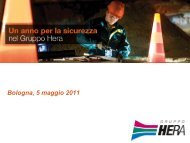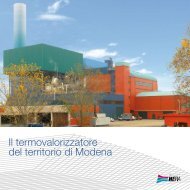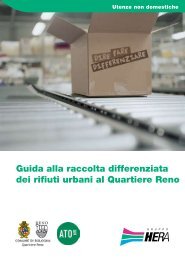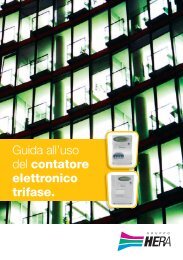I termovalorizzatori del Gruppo Hera - Il Gruppo Hera
I termovalorizzatori del Gruppo Hera - Il Gruppo Hera
I termovalorizzatori del Gruppo Hera - Il Gruppo Hera
Create successful ePaper yourself
Turn your PDF publications into a flip-book with our unique Google optimized e-Paper software.
dove vengono stoccate in attesa di essere destinateal trattamento di recupero, presso appositi centri, doveè possibile recuperare il materiale ferroso (10% circain peso) e un’altra frazione (il 70 % circa) riutilizzabilenella produzione <strong>del</strong> cemento.Al fine di limitare i consumi di acqua nell’impiantoè stato previsto un sistema di gestione <strong>del</strong>le acqueche consente il recupero e il riutilizzo <strong>del</strong>le stesse:gli spurghi prodotti nei vari punti <strong>del</strong>l’impianto sonorecuperati e riutilizzati laddove il fabbisogno idrico nonrichiede acqua con particolari caratteristiche, come adesempio per lo spegnimento <strong>del</strong>le scorie di combustione.I sistemi di alta tensione AT e media tensione MT sonocontrollati da un Sistema di Protezioni Comandoe Controllo (SPCC).L’impianto è collegato alla rete alta tensione (AT)attraverso un sistema elettrico di alta tensione(in esecuzione blindata per Ferrara, Forlì e Rimini,in esecuzione ibrida per Modena) tramite elettrodottointerrato.Tecnologia <strong>del</strong>l’impiantodi Bologna| 38<strong>Il</strong> sistema di combustione è <strong>del</strong> tipo a griglia mobilealternata, con raffreddamento parziale ad acqua.<strong>Il</strong> generatore di vapore è <strong>del</strong> tipo a circolazione naturaleed è integrato alla camera di combustione. La cameradi post-combustione è dotata di sistema di ricircolodei gas di combustione.<strong>Il</strong> sistema di depurazione fumi prevede un duplicesistema di trattamento in serie, costituito da un sistema asecco e uno a umido, inoltre a valle di quest’ultimo è inseritoun reattore catalitico DeNOx/DeDiox nel processo (SCR).<strong>Il</strong> sistema di trattamento a secco è costituito da unreattore e da un filtro a maniche e prevede l’iniezionedi sorbalit, per la neutralizzazione degli inquinanti acidie l’assorbimento dei microinquinanti (diossine, furani,metalli pesanti).<strong>Il</strong> sistema di trattamento a umido è costituito da una torredi lavaggio a doppio stadio e prevede l’iniezione idrossidodi sodio, per il completamento <strong>del</strong>la neutralizzazionedegli inquinanti acidi.<strong>Il</strong> sistema di recupero energetico è costituitoda una turbina a vapore collegata a un generatoresincrono per la produzione di energia elettrica,un condensatore di vapore ad acqua e il ciclo termico.<strong>Il</strong> sistema di recupero energetico è stato progettatoper ottenere un elevato rendimento elettrico.Per ridurre al minimo il consumo d’acqua è previsto,dove possibile, il recupero <strong>del</strong>le acque di processo;il più rilevante è quello <strong>del</strong>lo spurgo dalle torri evaporative<strong>del</strong> recupero energetico che è utilizzato per alimentarele torri di lavaggio fumi e le torri di condizionamento fumi.38 | Bologna, Torre evaporativa.Un sistema di controllo distribuito (DCS) consentedi gestire in modo automatico tutto l’impiantoda una sala di comando e controllo centralizzatae di supportare il personale di conduzione durantela propria attività. Le logiche implementate nelsistema di controllo centralizzato sono state elaboratedirettamente dal Settore Ingegneria Grandi Impianti.| 3737 | Modena, la sottostazioneelettrica.type steam turbine with controlledspillback, where, on expanding,it produces electricity by meansof an alternator operated bythe turbine; the energy recoverysystem includes an air cooledsteam condenser and the thermalcycle.The turbo-generator is able tooperate either in parallel withthe national electric grid orindependently (so-called isolatedoperation), producing the electricityneeded for the operation of theentire waste-to-energy plant, evenif there is no external electricalpower supply.The combustion slag, i.e. themineral and metal componentsof the waste that remain afterthe combustion process, falls intoa water bath extractor, whereit is cooled. It is then transportedon a conveyor belt that takesit to a dedicated building whereit is stored, waiting to be sentfor treatment at special centres,where the ferrous material can berecovered (around 10% in weight)and another portion (around 70%)can be reused in the productionof cement.In order to limit water consumptionin the plant, there is a watermanagement system that allowsthe water to be collected andreused: the discharges atthe various points in the plantare collected and reused wherethe water needed does not requirespecial characteristics, suchas the water used to put outthe combustion slag.A Distributed Control System (DCS)allows the entire plantto be managed automatically froma control room with centralisedoperation and the personnelto be supported during their work.The centralised control systemlogic used has been processeddirectly by Large Plant EngineeringDivision.The HV (high-voltage) and MV(medium-voltage) systemsare controlled by a Protection,Technology of the37 | Modena, the electricity substation. The flue gas cleaning system The wet-treatment system cycle. The energy recovery38 | Bologna, cooling tower.has a dual-treatment system is composed of a dual-stage system has been designedBologna plantin series, comprising a dry system washing tower and includes to achieve a high electricalCommand and Control System(SPCC).The plant is connected to the highvoltage(HV) network througha high-voltage electrical system(gas insulated switchgears forFerrara, Forlì and Rimini, andhybrid switchgears for Modena)with underground power lines.The combustion system is thealternating moving-grate type,with partial water cooling.The steam generator is thenatural-circulation type,integrated with the combustionchamber. The post-combustionchamber has a combustion gasrecirculation system.and a wet system. There is alsoa DeNOx/DeDiox catalytic reactor(SCR) downstream.The dry-treatment systemis composed of a reactorand a bag filter, and involvesthe injection of Sorbalit forthe neutralisation of acid pollutantsand adsorption of micro-pollutants(dioxins, furans, heavy metals).the injection of sodium hydroxideto complete the neutralisationof the pollutant acids.The energy recovery systemcomprises a steam turbineconnected to a synchronousgenerator for the productionof electricity, a water cooledsteam condenser and a thermalefficiency.In order to keep water consumptionto a minimum, the process wateris recovered, where possible;the blow down from the coolingtowers of the energy recoverysystem produces the largest amountof water and this is used to supplythe flue gas-washing towers andthe flue gas-conditioning towers.60 | I <strong>termovalorizzatori</strong> <strong>del</strong> <strong>Gruppo</strong> <strong>Hera</strong> | La tecnologiahera group’s waste-to-energy plants | Technology | 61
















